Méthode Champenoise is a traditional method of making sparkling wine, particularly champagne, where the second fermentation occurs in the bottle. It is a labor-intensive and time-consuming process that requires significant expertise, but results in wines with complex flavors and delicate bubbles. The Méthode Champenoise is a hallmark of the Champagne region of France and has become synonymous with high-quality sparkling wines around the world.
The process of Méthode Champenoise starts with a base wine that is made from specific grape varieties such as Chardonnay, Pinot Noir, and Pinot Meunier. The base wine is then bottled with a mixture of yeast and sugar, known as the liqueur de tirage. This mixture triggers a second fermentation in the bottle, producing carbon dioxide gas, which dissolves into the wine and creates bubbles.
The wine is then aged on the lees, the dead yeast cells left over from the fermentation process, for a period of time ranging from several months to several years. During this time, the wine develops complex flavors and aromas from the yeast cells. The lees are then removed from the bottle through a process called riddling, where the bottles are gradually turned and angled until the lees settle in the neck of the bottle.
The neck of the bottle is then frozen, and the lees are disgorged or removed by opening the bottle and allowing the pressure to expel the lees. The bottle is then topped up with a mixture of wine and sugar known as the dosage, which determines the sweetness level of the finished wine. The wine is then corked and aged for an additional period before release.
Méthode Champenoise is a complex and costly process that requires significant attention to detail, as well as expertise in blending, aging, and disgorging the wine. It is often regarded as the gold standard for producing high-quality sparkling wines, particularly champagne, and has become a hallmark of the Champagne region of France.
The term Méthode Champenoise is regulated by law in many countries, including France and the European Union, and can only be used for wines that are produced using this specific method. In the United States, the term Méthode Champenoise has been replaced by the term Méthode Traditionnelle, but the process remains the same.
While Méthode Champenoise is most commonly associated with champagne, it is also used to produce other sparkling wines around the world, including Cava in Spain, Franciacorta in Italy, and many New World sparkling wines.
Overall, Méthode Champenoise is an important and historic winemaking technique that has become synonymous with high-quality sparkling wines. It requires significant expertise and attention to detail, but the result is a wine that is complex, nuanced, and worthy of celebration.
Wine is sunlight, held together by water.”- Galileo Galilei


